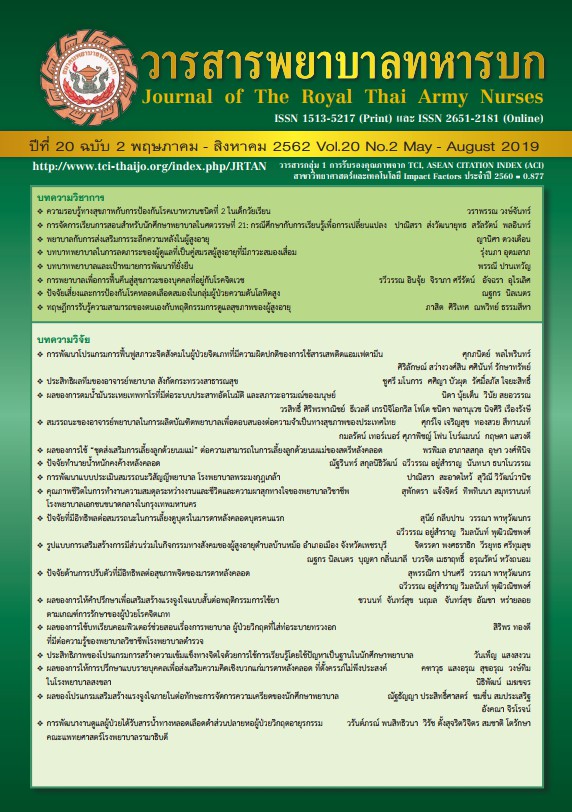Predicting Factors of Parents Caring Behavior for Exacerbation Prevention in School- Age Children with Allergic Rhinitis
Keywords:
Allergic Rhinitis, Parents Caring Behavior for Exacerbation Prevention, School-age Children with Allergic RhinitisAbstract
The purpose of this study were to determine the factors that predictors of parents caring behavior for exacerbation in school-age children with allergic rhinitis. This study sample included 213 parents of school-age children with allergic rhinitis. From using of multi-stage random sampling. Data were analyzed using descriptive statistic pearson’s product moment correlation coefficient and stepwise multiple regression. The major finding were as follows: 1) Parents caring behavior for exacerbation prevention in school-age children with allergic rhinitis was at appropriate high level ( = 150.87, S.D. = 3.21) 2) Perceived self-efficacy, Perceived benefit, emotional support, appraisal support, instrumental support, income and information support were positively significantly correlated with parents caring behavior for exacerbation prevention in school-age children with allergic rhinitis. (r= .497, .403, .306, .279, .263, .237 and .227, p < .01 at respectively) and perceived barrier were negatively significantly correlated with parents caring behavior for exacerbation prevention in school-age children with allergic rhinitis. (r = -.361, p < .01) and 3) Perceived self-efficacy (β = .351), perceived benefit (β = .311), income (β = .150) and perceived barrier (β = -.133) were significant predictors and together account for 36.7 percent of the parents caring behavior for exacerbation prevention in school-age children with allergic rhinitis (R2 = .367, p < .05)
Downloads
References
Thongru S. & ngampaiboon C. Prevalence of Allergy Disease in Surin Provine. Khon Kaen hospital medical journal 2009; 32(9): 393-399. (in Thai)
Poachanukoon O. & Kitcharoensakkul M. Snoring and Sleep Problems in Children with and without Allergic Rhinitis: A Case Control Study. Department of Pediatrics, Faculty of Medicine, Thammasat University, Pathumthani, Thailand 2015; 98 (2 Suppl): S138-S144. (in Thai)
The Royal College of Otolaryngologists-Head and Neck Surgeons of Thailand. Guidelines for the development of allergic rhinitis in Thai people. (Update 2011). Sanofi Aventis (Thailand) Co., Ltd., GlaxoSmithKline (Thailand) Limited & MSD (Thailand) Co., Ltd. 2011; 79.
Kaewkungkwan S. Psychology of life development at all ages Book 1. 9th Edition. Bangkok: Thammasat University Press 2010; 324. (in Thai)
The Royal College of Pediatricians and the Pediatric Society of Thailand. A Guide for Parents to spread the knowledge of childcare and development (6-12 year olds). National Library of Thailand Cataloging in Publication Data; 2014.
Vichayanond P. et al. Clinical characteristics of children with non-allergic rhinitis vs with allergicrhinitis. Asian Pacific Allergy 2010; 28(40): 270-274.
Assanasen P. & Bunnag C. Allergic rhinitis. Journal of thai traditional & Alternative medicine 2009;7(7):71-82.
Cantani A. Pediatric Allergy, Asthma and Immunology. Springer Berlin Heidelberg NewYork; 2008.
Kiattirutwong N. Chronic illness care in primary care. Journal of public health nursing 2016; 30(1): 113-115.
Rojnawee S. Nursing Interventions for Children with Asthma in Thailand: Meta-Analysis. Journal of The Royal Thai Army Nurses 2017; 18(Supp January-April): 41-47. (in Thai)
Mehta P. “Allergic Rhinitis and Bronchial Asthma.” supplement to Journal of the association of physicians of india 2014; 62: 23-26.
Tamay Z., Akcay A., Ones U. et al. Prevalence and risk factors for allergic rhinitis in primary school children. International Journal of Pediatric Otorhinolaryngology 2007; 71: 463-471.
Cohen J. Statistical power analysis for the behavioral science. (2nded). Hillsdale, NJ: Lawrence Erlbaum Associates; 1988.
Muangchang Y. Care behaviors of school-age children’s mothers regarding prevention of symptoms of allergic rhinitis. Maternal and child nursing, Mahidol University. Master of nursing science; 2000.
Pender N. J., Murdaugh C. L. & Parson M. A. Health Promotion in nursing Practice. New Jersey: Pearson Education Inc; 2006.
House J. S. Work stress and social support. California: Addision-Wesley; 1981.
Polit D. F. & Beck C. T. Nursing Research: Generating and Assessing Evidence for Nursing Practice. 8thed. London: Lippincott; 2008.
Nitirungraung P. & Ua-kit N. Factors predicting allergic symptoms preventive behavior among school-age children. Journal of public health nursing 2013; 27(2): 72-84. (in Thai)
Somdee P. symptomatic preventive behavior of allergic rhinitis in school-age children and its related factors. Journal of public health nursing 2015; 1(12): 43-53. (in Thai)
Thongkanya R. & Preechawong S. Factors Predicting Second-hand Smoke Avoidance Behavior in Chronic Illness Patients, Bangkok Metropolis. Journal of The Royal Thai Army Nurses 2017; 15(2): 331-338. (in Thai)
Kaewsuk C. Factors Associated with Maternal Behavior in Prevention of Acute Respiratory Infection in Preschool Children. The Journal of Faculty of Nursing Burapha University 2016; 24(4): 54-64.
Areegarnlert N. et al. Caregiver Management of Asthma Triggers within the Home Environment. Journal of Nursing Science 2010; 28(4): 76-85. (in Thai)
Jaide C. Factors related to child worker’s behavior in prevention of acuterespiratory infaction in child care centers. Ramathibodi Nursing Journal 2011; 18(3): 389-403. (in Thai)
Downloads
Published
How to Cite
Issue
Section
License
บทความหรือข้อคิดเห็นใดใดที่ปรากฏในวารสารพยาบาลทหารบกเป็นวรรณกรรมของผู้เขียน ซึ่งบรรณาธิการหรือสมาคมพยาบาลทหารบก ไม่จำเป็นต้องเห็นด้วย
บทความที่ได้รับการตีพิมพ์เป็นลิขสิทธิ์ของวารสารพยาบาลทหารบก
The ideas and opinions expressed in the Journal of The Royal Thai Army Nurses are those of the authors and not necessarily those
of the editor or Royal Thai Army Nurses Association.






